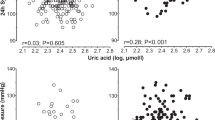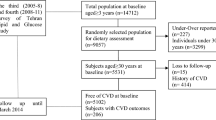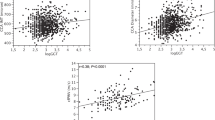Abstract
It has been suggested that increased oxidative stress may be both a cause as well as a consequence of hypertension. In vivo oxidation of low-density lipoproteins by oxygen-free radicals may increase hypertension-related atherogenesis, and antioxidants may be beneficial in this regard. Previous findings concerning associations between serum measures of antioxidants and hypertension have however been inconsistent. Plasma levels of β-carotene, Vitamin A, E, uric acid, homocysteine and total antioxidant capacity, as well as two markers of oxidative stress, malondialdehyde (MDA) and protein carbonyls, were measured in morning fasting blood samples provided by 415 Australians aged 60–64 years, selected randomly from the community. Participants also provided information on sociodemographic attributes, mental and physical health, and provided two measures of resting blood pressure, allowing a diagnosis of definite or borderline hypertension. Those with hypertension had lower levels of β-carotene and higher levels of uric acid and MDA compared to normotensive participants. The last two of these associations persisted when the analyses controlled for lifestyle and health factors. The findings from this study offer limited support for the proposition that lower antioxidant status and higher oxidative stress are associated with hypertension, and suggest the need for longitudinal studies to examine causality and intervention studies to determine the benefit of antioxidants in this group.
This is a preview of subscription content, access via your institution
Access options
Subscribe to this journal
Receive 12 digital issues and online access to articles
$119.00 per year
only $9.92 per issue
Buy this article
- Purchase on Springer Link
- Instant access to full article PDF
Prices may be subject to local taxes which are calculated during checkout
Similar content being viewed by others
References
Griedling KK, Fitzgerald GA . Oxidative stress and cardiovascular injury. Part II. Animal and human studies. Circulation 2003; 108: 2034–2040.
Oparil S, Zaman MA, Calhoun DA . Pathogenesis of hypertension. Ann Int Med 2003; 139: 761–776.
Kumar KV, Das UN . Are free radicals involved in the pathobiology of human essential hypertension? Free Radic Red Commun 1993; 19: 59–66.
Beckman KB, Ames BN . The free radical theory of aging matures. Physiol Rev 1998; 78: 547–581.
Jessup W, Kritharides L, Stocker R . Lipid oxidation in atherogenesis: an overview. Biochem Soc Trans 2004; 32: 134–138.
Maxwell SR . Can anti-oxidants prevent ischaemic heart disease? J Clin Pharm Ther 1993; 18: 85–95.
Heart Protection Study Collaborative Group. MRC/BHF Heart Protection Study of antioxidant vitamin supplementation in 20 536 high-risk individuals: a randomised placebo-controlled trial. Lancet 2002; 360: 23–33.
Klipstein-Grobusch K, Geleijnse JM, den Breejen JH . Dietary antioxidants and risk of myocardial infarction in the elderly: the Rotterdam Study. Am J Clin Nutr 1998; 69: 261–266.
Yochum LA, Folsom AR, Kushi LH . Intake of antioxidant vitamins and risk of death from stroke in postmenopausal women. Am J Clin Nutr 2000; 72: 476–483.
Asplund K . Antioxidant vitamins in the prevention of cardiovascular disease: a systematic review. J Intern Med 2002; 251: 372–392.
Duffy SJ et al. Treatment of hypertension with ascorbic acid. Lancet 1999; 354: 2048–2049.
Kim MK et al. Lack of long-term effect of Vitamin C supplementation on blood pressure. Hypertension 2002; 40: 797–803.
Ness AR, Chee D, Elliott P . Vitamin C and blood pressure — an overview. J Hum Hypertens 1997; 11: 343–350.
Chen J et al. Serum antioxidant vitamins and blood pressure in the United States population. Hypertension 2002; 40: 810–816.
Ware JE, Kosinski M, Keller SD . A 12-item Short Form Health Survey. Med Care 1996; 34: 220–233.
Catignani GL . Simultaneous determination of retinol and alpha tocopherol in serum and plasma by liquid chromatography. Clin Chem 1983; 29: 708–712.
Pilz J, Meineke I, Gleiter CH . Measurement of free and bound malondialdehyde in plasma by high-performance liquid chromatography as the 2,4-dinitrophenyl-hydrazine derivative. J Chromatogr B Biomed Sci Appl 2000; 9: 315–325.
Roberts PA, Knight J, Campbell AK . Pholasin: a bioluminescent indicator for detecting activation of single neutrophilis. Anal Biochem 1987; 160: 139–148.
Buss H et al. Protein carbonyl measurement by a sensitive ELISA method. Free Radic Biol Med. 1997; 23: 361–366.
Winterbourn CC, Buss IH . Protein carbonyl measurement by enzyme-linked immunosorbent assay. Methods Enzymol 1999; 300: 106–111.
Fossati P, Prencipe L, Berti G . Use of 3,5-dichloro-2-hydroxybenzenesulfonic acid/4-aminophenazone chromogenic system in direct enzymic assay of uric acid in serum and urine. Clin Chem 1980; 26: 227–231.
Statacorp . Stata Statistical Software: Release 7.0. Stata Corporation: College Station, TX, 2001.
Comstock GW et al. Serum levels of retinol, beta-carotene, and alpha-tocopherol in older adults. Am J Epidemiol 1988; 127: 114–123.
Goodman DS . Vitamin A and retinoids in health and disease. N Engl J Med 1984; 310: 1023–1031.
Galley HF et al. Combination oral antioxidant supplementation reduces blood pressure. Clin Sci 1997; 92: 361–365.
Miller ER, Appel LJ, Levander OA, Levine DM . The effect of antioxidant vitamin supplementation on traditional cardiovascular risk factors. J Cardiovasc Risk 1997; 4: 19–24.
Russo C et al. Anti-oxidant status and lipid peroxidation in patients with essential hypertension. J Hypertens 1998; 16: 1267–1271.
Palumbo G et al. Effects of vitamin E on clinic and ambulatory blood pressure in treated hypertensive patients. Am J Hypertens 2000; 13: 564–567.
Rossell M, Regnstrom J, Kallner A, Hellenuis M-L . Serum urate determines antioxidant capacity in middle-aged men—a controlled, randomized diet and exercise intervention study. J Int Med 1999; 246: 219–226.
Simie MG, Jovanovic SV . Antioxidation mechanisms of uric acid. J Am Chem Soc 1989; 111: 5778–5782.
Wayner DDM et al. The relative contributions of vitamin E, urate, ascorbate and proteins to the total peroxyl radical-trapping antioxidant activity of human blood plasma. Biochem Biophys Acta 1987; 924: 408–419.
Johnson RJ et al. Is there a pathogenetic role for uric acid in hypertension and cardiovascular and renal disease? Hypertension 2003; 41: 1183–1190.
Mazzali M et al. Elevated uric acid increases blood pressure in the rat by a novel crystal-independent mechanism. Hypertension 2001; 38: 1101–1106.
Wen Y, Killalea S, McGettigan P, Feely J . Lipid peroxidation and antioxidant vitamins C and E in hypertensive patients. Ir J Med Sci 1996; 165: 210–212.
Janero DR . Malondialdehyde and thiobarbituric acid-reactivity as diagnostic indices of lipid peroxidation and peroxidative tissue injury. Free Radic Biol Med 1990; 9: 515–540.
Cuccurollo F et al. Aortic glutathione-related antioxidant defences in rabbits subjected to suprarenal aortic coarctation hypertension. J Mol Cell Cardiol 1991; 23: 727–734.
Acknowledgements
We thank Helen Christensen, Bryan Rodgers, Karen Maxwell, Trish Jacomb and the team of interviewers from the Centre for Mental Health Research for their assistance with this study. We also thank Paul Stathakis, Department of Clinical Chemistry, for his technical assistance.
Author information
Authors and Affiliations
Corresponding author
Rights and permissions
About this article
Cite this article
Parslow, R., Sachdev, P., Salonikas, C. et al. Associations between plasma antioxidants and hypertension in a community-based sample of 415 Australians aged 60–64. J Hum Hypertens 19, 219–226 (2005). https://doi.org/10.1038/sj.jhh.1001809
Received:
Revised:
Accepted:
Published:
Issue Date:
DOI: https://doi.org/10.1038/sj.jhh.1001809
Keywords
This article is cited by
-
Serum Malondialdehyde Levels in Hypertensive Patients: A Non-invasive Marker of Oxidative Stress. A Systematic Review and Meta-analysis
High Blood Pressure & Cardiovascular Prevention (2022)
-
Consumption of healthy foods at different content of antioxidant vitamins and phytochemicals and metabolic risk factors for cardiovascular disease in men and women of the Moli–sani study
European Journal of Clinical Nutrition (2013)
-
Towards understanding the aetiology and pathophysiology of human hypertension: where are we now?
Journal of Human Hypertension (2006)



